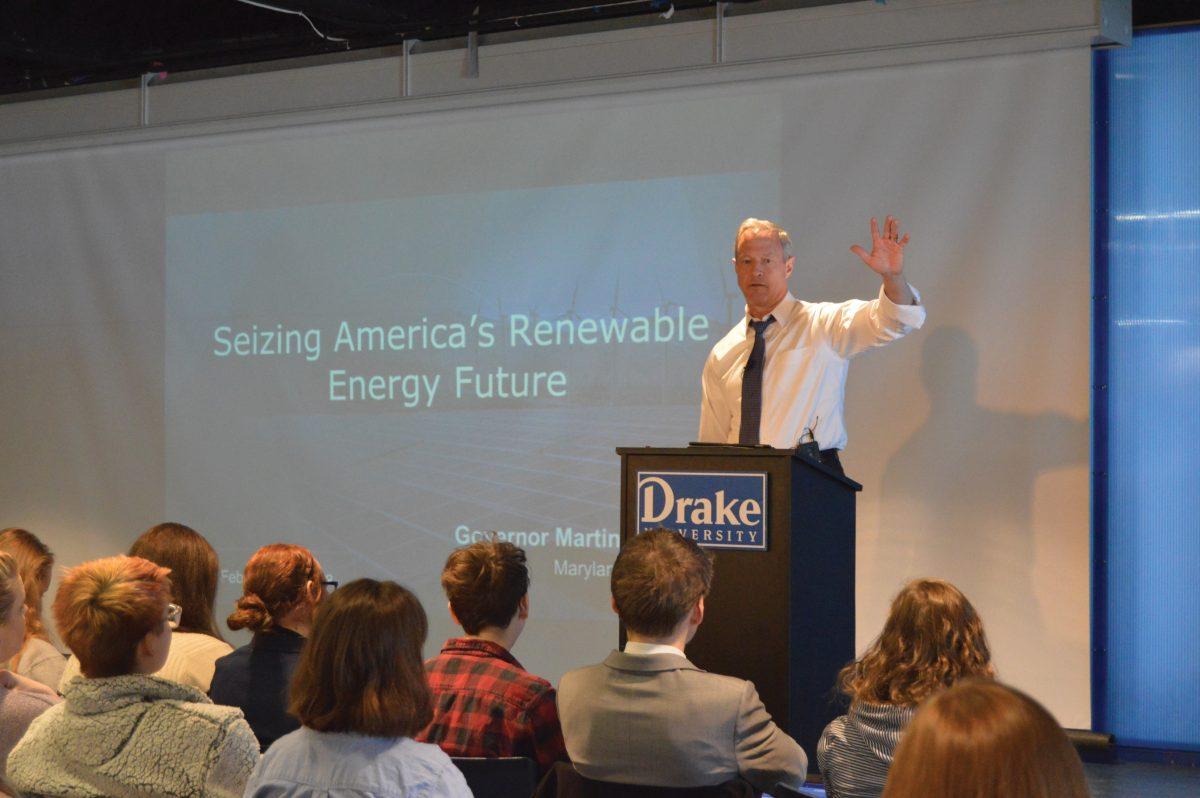BY MADDIE TOPLIFF
Martin O’Malley, former 2016 presidential election candidate, paid Drake University a visit last Tuesday to promote renewable energy in a presentation titled “Seizing America’s Renewable Energy Future.”
O’Malley began his presentation by saying renewable energy is “near and dear” to his heart, informing the audience that he had been the first presidential candidate to propose moving to a 100 percent renewable energy grid by 2050. The Democratic Party liked O’Malley’s idea so much that they adapted it for the entire party’s platform.
O’Malley went on to claim that wind and solar energy will make up at least 50 percent of electricity generation by 2030, which prompted a positive response.
“Here in Iowa, I really support wind,” Kaplan University student Kara Ryan said, sharing that O’Malley’s presentation made her want to research the topic further.
According to O’Malley’s acquired data, wind power has the potential to drop in cost by 50 percent before 2030, making for a great investment opportunity.
“Climate change is the greatest business opportunity to come to the USA in 100 years,” O’Malley said. “It’s about a future of more.”
O’Malley’s optimistic claims do force him, however, to inquire about humans’ actual motivation to want to push toward a more renewable future in energy, a fact he shared with the crowd.
“Can we as a species make this happen quickly enough?” he asked. “And can we as Americans square ourselves for this future and seize these opportunities?”
The former governor of Maryland revealed that Hawaii has already accepted the challenge: the Aloha State is consciously aiming for 100 percent renewable power by 2045.
While O’Malley’s primary focus was on the promotion of renewable energy, he commented on the Trump administration’s lack of pursuit on the subject.
“Don’t tell me we can’t afford (renewable energy),” O’Malley said, after sharing his distaste for the recent tax cuts directed toward wealthy Americans.
President Trump has made controversial decisions in the realms of both climate change and renewable energy during his term. Most recently, he stated at the State of the Union address that his administration has “ended the war on beautiful, clean coal,” leaving some viewers scratching their heads. Trump also backed out of the Paris Agreement in his first year of office, citing coal development once again as his rationale.
One of the primary problems with coal is that it’s not a renewable natural resource, and once it’s gone, it’s not coming back, and neither are the jobs. According to Vox, 27 coal plants closed in 2017 alone.
Heaven Chamberlain, a student at Des Moines Area Community College, asked about the very same jobs during the Q&A portion of O’Malley’s presentation, wondering where the miners are going to work after the coal is gone.
“I was very satisfied (with O’Malley’s answer) because he believes we need to offer more money to training,” Chamberlain said. “The problem is that Donald Trump is lying to these coal miners and saying we’re going to bring back coal jobs. There’s no way to bring back coal jobs.”
O’Malley’s use of the word “training” refers to providing resources for former coal miners to use to acquire the skills they need to reenter the workforce in pursuit of a different career.
Although O’Malley’s presentation expressed a lot of distaste for the current political climate, he also expressed hope.
“Darkness makes a great canvas,” O’Malley said, predicting the next president of the United States will be a champion for renewable energy. “America does, in fact, change.”







